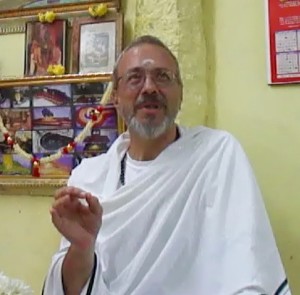By Swami Advayatmananda
Download PDF
(Excerpts originally published in the 2021 Arsha Vidya Gurukulam Souvenir)
असितगिरिसमं स्यात्कज्जलं सिन्धुपात्रे
सुरतरुवरशाखा लेखनी पत्रमुर्वी ।
लिखति यदि गृहीत्वा शारदा सर्वकालं
तदपि तव गुणानामीश पारं न याति ॥ ३२ ॥
asitagirisamaṁ syātkajjalaṁ sindhupātre
surataruvaraśākhā lekhanī patramurvī ।
likhati yadi gṛhītvā śāradā sarvakālaṁ
tadapi tava guṇānāmīśa pāraṁ na yāti ॥ 32 ॥
“Should the ink be the black mountains, contained in the ink pot of the ocean;
Should the pen be a branch of the greatest heavenly tree, and the writing paper the entire earth; If even Śāradā, Goddess Saraswati herself were to take these and write for all time; Still she would never reach the end, O Lord, of your glorious attributes!”
This beautiful śloka from the Śivamahimnastotram in praise of Lord Śiva reveals the vision of advaita, non-duality, as expressed through the heart of a bhakta, a devotee.
Lord Śiva is presented in several complementary ways in the śāstra, scriptures. On one hand, he is represented as a family man, with wife, Pārvatī, and two sons, Subrahmaṇya and Gaṇapati. As such this form represents the pravṛtti-mārga—the lifestyle of a gṛhastha, householder, engaged in the world, leading the prayerful life of karma-yoga through which one transforms one’s entire life into a prayer, into a sādhana, spiritual practice.
Śiva is also represented as a tyāgī and yogī—an ascetic deeply absorbed in nididhyāsana, contemplation, representing the nivṛtti-mārga—the lifestyle of a saṁnyāsī who has embraced a life of voluntary simplicity and meditation dedicated to the pursuit of ātma-vidyā, self-knowledge.
Lord Śiva is also presented as the guru, teacher, in the form of Śrī Dakṣiṇāmūrti—the one who fearlessly faces south, south representing saṁsāra, the life filled with endless struggle and death, teaching his śiṣyas, students, the essence of the Upaniṣads, as kara-kalita-cin-mudra—the one whose hand is in the form of the cin-mudrā—the physical representation of the mahāvākya tat tvam asi.
This mahāvākya is the jīva-īśvara-aikya-bodhaka-vākya—the statement which, when fully understood through the unfoldment by a qualified teacher—directly reveals the oneness, non-separateness of the individual and the Lord. This direct knowledge enables the student to understand and hold the transformative vision that all that is here is one reality, Īśvara.
Pujya Swami Dayananda was fond of urging mumukṣus, spiritual aspirants, to “Īśvara-ize” the world and one’s life experiences. This is because the more one brings Īśvara into one’s life, the closer one is to reality, truth, because there is nothing here but Īśvara. As the karma-phala-dātā, the giver of the results of one’s previous actions, the Lord is present in every situation that appears in the unfoldment of the storyline of one’s life. As such, Lord Śiva appears in his potentially frightening form as the fructification of one’s pāpa, presenting us with obstacles and challenges, and also in his beneficent form, as the fructification of one’s puṇya, blessing us with opportunities and abundance.
And as jagataḥ abhinna-upādāna-kāraṇa, the non-separate material cause of all creation, Lord Śiva is the very stuff of creation—non-separate from the creation itself. The entire jagat, universe, and all of one’s life experiences are a manifestation of Lord Śiva’s guṇas, qualities, attributes, glories. He is parameśvara, the limitless Lord. Nothing can be separate from that which is limitless. He is satyam and mithyā, the real and the apparent; kāraṇa and kārya, cause and effect; nirguṇa and saguṇa, free of all qualities, yet manifesting as all nāma-rūpas, all names and forms.
Even Goddess Saraswati is unable to define the limitless, unable to enumerate the endless glories of Lord Śiva. He Īśa, O Lord, no one can ascertain the limit of your attributes, of your glories. All attributes and glories are yours. Even the glories I mistakenly claim as my own are nothing but your glories. Who could reach the limit your glories? Who can describe the limitless? You are limitless. You are everything. You are in fact ātmā, my very being. Wherever I look, I see nothing but you, and my heart overflows with wonderment and devotion.
॥ॐ तत्सत्॥
Om Tat Sat
©2021 Arsha Drishti













